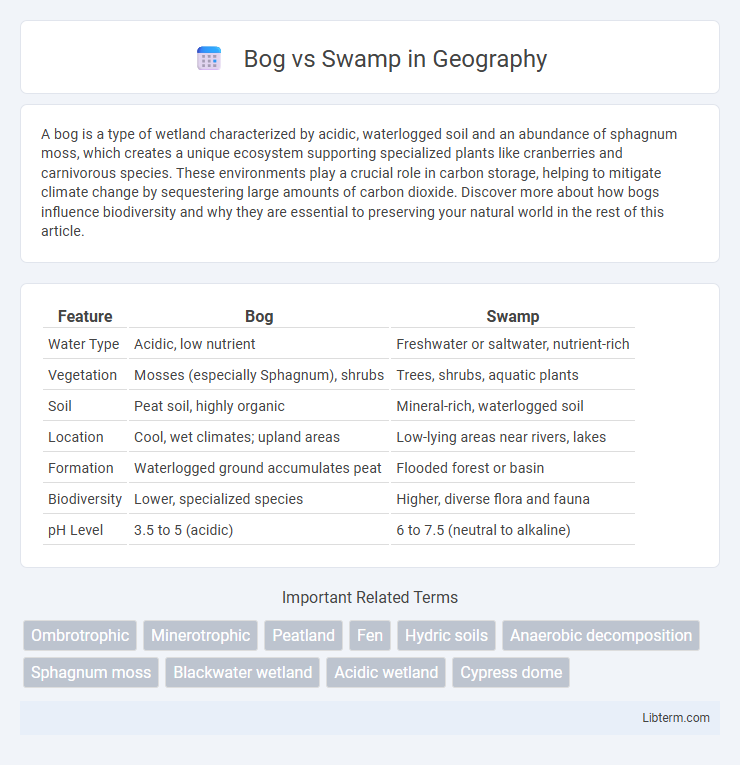A bog is a type of wetland characterized by acidic, waterlogged soil and an abundance of sphagnum moss, which creates a unique ecosystem supporting specialized plants like cranberries and carnivorous species. These environments play a crucial role in carbon storage, helping to mitigate climate change by sequestering large amounts of carbon dioxide. Discover more about how bogs influence biodiversity and why they are essential to preserving your natural world in the rest of this article.
Table of Comparison
| Feature | Bog | Swamp |
|---|---|---|
| Water Type | Acidic, low nutrient | Freshwater or saltwater, nutrient-rich |
| Vegetation | Mosses (especially Sphagnum), shrubs | Trees, shrubs, aquatic plants |
| Soil | Peat soil, highly organic | Mineral-rich, waterlogged soil |
| Location | Cool, wet climates; upland areas | Low-lying areas near rivers, lakes |
| Formation | Waterlogged ground accumulates peat | Flooded forest or basin |
| Biodiversity | Lower, specialized species | Higher, diverse flora and fauna |
| pH Level | 3.5 to 5 (acidic) | 6 to 7.5 (neutral to alkaline) |
Understanding the Difference: Bog vs Swamp
Bogs and swamps are both types of wetlands but differ primarily in water chemistry and vegetation; bogs are acidic, nutrient-poor, and dominated by mosses like sphagnum, while swamps have neutral to alkaline water and are characterized by woody plants such as trees and shrubs. Bogs accumulate peat due to slow decomposition in waterlogged conditions, whereas swamps support diverse ecosystems with better soil drainage and nutrient availability. Understanding these distinctions helps in ecological conservation and wetland management strategies.
Defining Features of Bogs
Bogs are characterized by their acidic, nutrient-poor waters and accumulation of peat formed primarily from sphagnum moss. Unlike swamps, which have standing water and abundant woody vegetation, bogs support low plant diversity dominated by mosses, ericaceous shrubs, and carnivorous plants. The water in bogs is mainly derived from precipitation rather than groundwater or streams, resulting in unique chemical and biological conditions.
Key Characteristics of Swamps
Swamps are wetlands characterized by saturated soils and abundant standing water, typically supporting dense forests dominated by water-tolerant trees like cypress and mangroves. Unlike bogs, swamps have higher nutrient levels and more alkaline conditions, promoting greater biodiversity and faster decomposition rates. Their complex hydrology includes both surface and groundwater flows, which sustain diverse aquatic and terrestrial ecosystems.
Formation Processes: How Bogs and Swamps Develop
Bogs develop through the gradual accumulation of peat as sphagnum moss grows in waterlogged, nutrient-poor conditions, leading to acidic, oxygen-deprived environments that slow decomposition. Swamps form in low-lying areas with standing or slow-moving freshwater, where trees and shrubs thrive in nutrient-rich, oxygenated soils, often resulting from flooding or natural changes in water flow. These distinct water and soil conditions define the contrasting ecosystems and biodiversity of bogs and swamps.
Vegetation Differences: Plants in Bogs and Swamps
Bogs are characterized by sphagnum mosses, ericaceous shrubs, and carnivorous plants such as pitcher plants and sundews, thriving in acidic, nutrient-poor conditions. Swamps support a diverse assemblage of hydrophilic trees and shrubs like cypress, tupelo, and willows, benefiting from nutrient-rich, oxygenated waters. The distinct vegetation in bogs and swamps reflects their unique hydrology and soil chemistry, influencing ecosystem biodiversity and function.
Water Sources and Hydrology Comparison
Bogs primarily receive water from precipitation, resulting in nutrient-poor, acidic conditions that slow decomposition, while swamps are fed mainly by groundwater or surface water, creating nutrient-rich, oxygenated environments that support diverse plant life. The hydrology of bogs features stagnant, low-flow water tables elevating peat accumulation, whereas swamps exhibit more dynamic water movement with fluctuating water levels driven by inflows and outflows. These differing water sources and hydrological processes define distinct ecosystems with unique vegetation and soil characteristics.
Wildlife Habitats: Unique Species in Bogs vs Swamps
Bogs support specialized wildlife such as carnivorous plants like sundews and pitcher plants, as well as unique species like the bog turtle and certain dragonflies adapted to acidic, nutrient-poor conditions. Swamps provide habitats for diverse amphibians, reptiles, and birds, including alligators, herons, and turtles, due to their nutrient-rich, water-saturated environments with abundant trees and vegetation. The contrasting water chemistry and vegetation structure in bogs and swamps create distinct ecosystems that sustain different specialist species essential for biodiversity.
Geographic Distribution of Bogs and Swamps
Bogs are predominantly found in cooler, northern regions such as Canada, Scandinavia, and Russia, where they form in glacial depressions with poor drainage. Swamps occur more widely across temperate and tropical zones, including the southeastern United States, the Amazon Basin, and parts of Africa and Australia, thriving in floodplains and along river margins. These distinct geographic distributions reflect differences in climate, hydrology, and vegetation adapted to each wetland type.
Ecological Importance and Environmental Roles
Bogs and swamps play crucial roles in maintaining biodiversity and regulating water cycles, with bogs acting as carbon sinks due to their dense peat accumulation and acidic conditions that slow decomposition. Swamps provide critical habitats for a variety of flora and fauna, supporting nutrient-rich environments that help filter pollutants from surface water. Both ecosystems contribute significantly to flood control, groundwater recharge, and climate regulation by storing large amounts of water and organic material.
Conservation Challenges and Protection Efforts
Bogs and swamps face significant conservation challenges due to habitat destruction, drainage for agriculture, and climate change impacts altering their hydrology and biodiversity. Protecting these wetlands requires implementing strict land-use regulations, restoring natural water flow, and promoting community engagement in conservation programs. Preservation efforts focus on maintaining these ecosystems' carbon sequestration capabilities and supporting vulnerable species dependent on these unique habitats.
Bog Infographic

 libterm.com
libterm.com